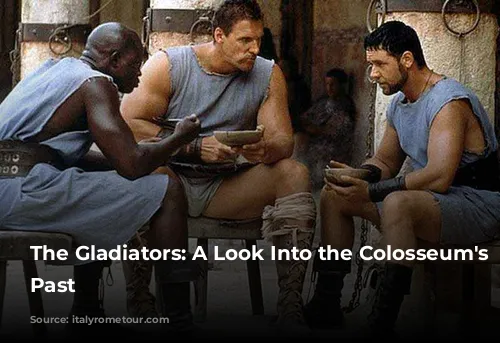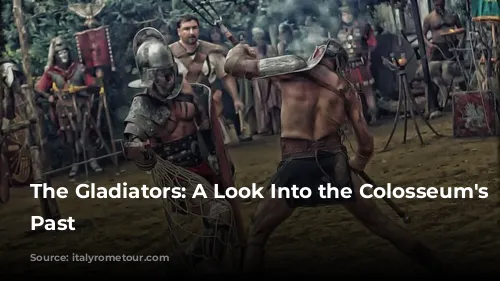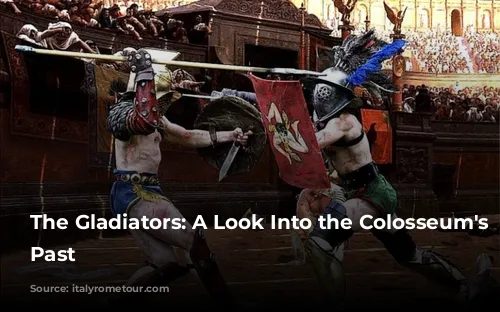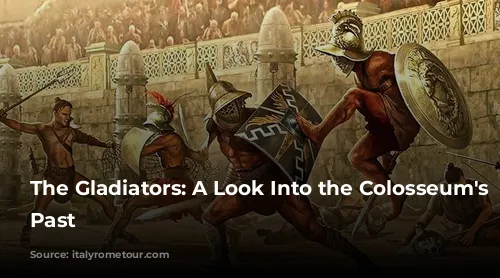It’s hard to imagine the scenes of violence and spectacle that unfolded within the Colosseum in ancient Rome. Gladiators, men trained for combat and death, were the stars of these brutal displays. But who were these warriors, and what really transpired within the arena’s walls?

The Birth of Gladiator Combat
The concept of gladiator duels finds its roots in the Etruscan civilization, a culture that heavily influenced the Romans. Just as the Romans adopted many Etruscan customs, they also embraced the practice of gladiatorial combat. The earliest recorded gladiator show took place in 264 BC, though it wasn’t until 105 BC that these spectacles became public events, open to the masses.

The Fighters: From Slaves to Heroes
Gladiators were a diverse group, hailing from various backgrounds. Most were slaves, but also included convicts, criminals, prisoners of war, and even free men. These warriors, usually aged 20 to 35, stood around 5’6″ tall – the average height for the time.
Gladiators were trained in special schools, the most renowned being the Ludus Magnus, where they lived and trained under strict supervision. They underwent rigorous daily workouts, fueled by a diet of vegetables, legumes, honey, and dairy products, and were judged for their skill and physical prowess, assigned to different fighting categories.

A Glimpse into the Arena
The gladiator games were elaborate affairs. Before the battles began, a grand parade entered the arena. First, the financier of the event appeared, followed by attendants carrying signs outlining the day’s program. Then came the slaves, carrying the gladiators’ weapons, and finally, the fighters themselves and those condemned to death. After paying respects to the emperor, the gladiators prepared for battle.

Fighting Styles: A Cast of Characters
Gladiators fought in different styles, each characterized by their unique weapons and armor. Mirmillones were heavily armored, wielding a sword and shield. Thracians fought with a curved sword and a small shield. Secutors, known as “pursuers,” were heavily armored and chased their opponents. Retiarii, the lowest class, fought only in a tunic, using a net, trident, and dagger. While considered less skilled by some, the Retiarii were beloved by the crowds, as their faces were visible, allowing audiences to connect with them.
The Fate of the Fighter: Life or Death
After a gladiator vanquished his opponent, he would turn to the audience of the amphitheater, awaiting their judgment. A thumbs up, symbolizing “mitte” (safe), meant the gladiator would live. A thumbs down, “jugula” (death), meant he would be executed. Ultimately, however, the emperor or the event organizer held the final say over the defeated gladiator’s fate.
The cost of a gladiator’s life was high, and death wasn’t easily requested. The battles were often inspired by mythological stories or grotesque situations, designed to entertain and excite the crowds.
Beyond Gladiators: Venationes, the Animal Battles
In addition to gladiator combat, the Colosseum hosted venationes, which pitted gladiators against wild animals. Lions, tigers, leopards, elephants, bears, deer, wild goats, and camels were among the creatures that faced these warriors. The lion, known for its ferocity, was particularly popular during these events. Pompey even held the infamous record of killing 600 lions in a single spectacle.
Gladiators: More Than Just Fighters
These men and women, often facing death in the arena, were not just slaves or criminals. They were heroes who fought for life, freedom, and glory. Their strength and courage captivated the Roman public, making them celebrities of their time.
The infamous reputation of gladiators, often labeled as outcasts, prostitutes, or pimps, didn’t stop them from being sex symbols. Their charisma and skill attracted admiration, even among nobles, like Eppia, who famously abandoned her husband for a gladiator.
Reality vs. Myth: A Deeper Look
While gladiatorial combat is often portrayed as pure brutality, recent research paints a different picture. A study analyzing the skeletal remains of gladiators suggests that their fights were more than just massacres. They followed specific rules, enforced by referees, making them more akin to wrestling matches than chaotic bloodbaths.
The study revealed that some gladiators, after losing their fights, were put to death not during the battles, but later, in the wings of the arena. They were executed with a hammer blow to the head, a grim and inglorious end.
The Decline of Gladiatorial Combat
The popularity of gladiatorial shows reached its peak during the Roman Empire, with the Flavian dynasty, under Emperor Vespasian, constructing the Colosseum, the most iconic amphitheater in the world. However, Emperor Constantine I, after converting to Christianity, outlawed these spectacles in the 4th century.
While the gladiators were ultimately silenced, their legend endures. They represent a brutal and fascinating facet of Roman history, embodying the values of courage, skill, and the allure of spectacle. Their story serves as a reminder of the complex and sometimes brutal nature of the past.
